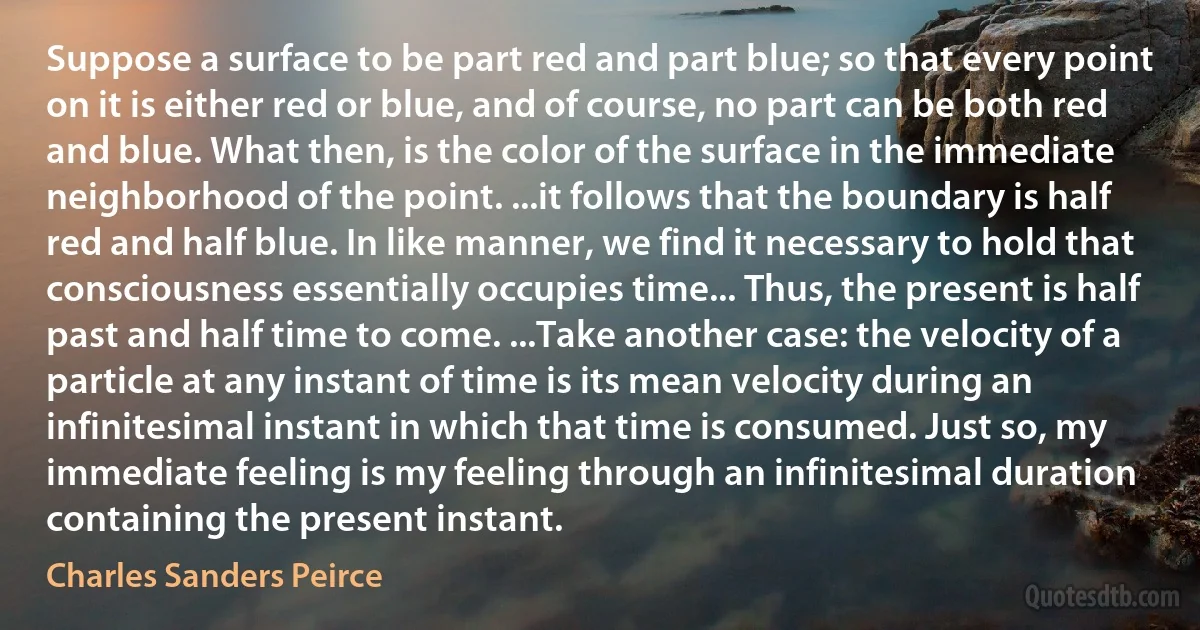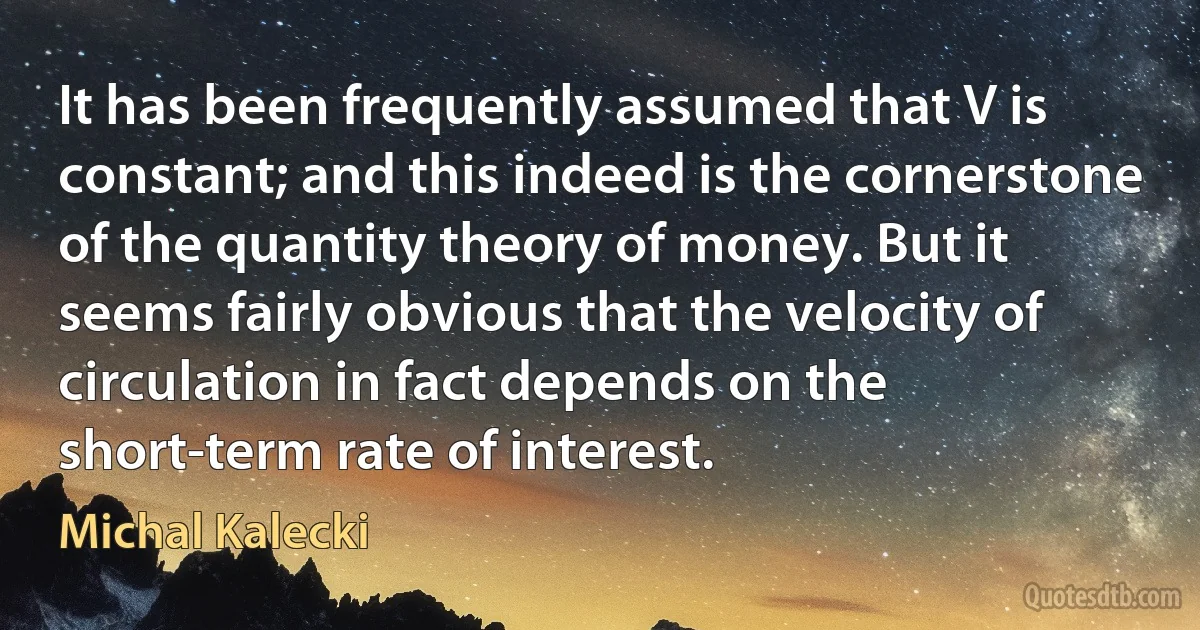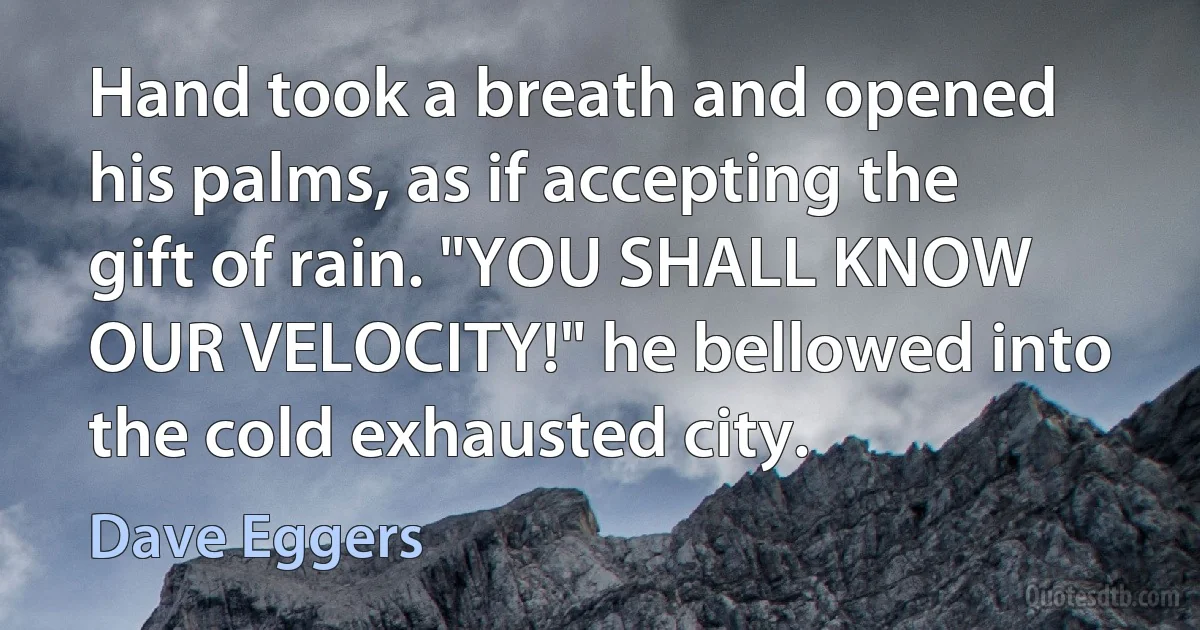Velocity Quotes - page 2
There are particular movements in particular epochs in which the Divine Force manifests itself with supreme power shattering all human calculations, making a mock of the prudence of the careful statesman and the scheming politician, falsifying the prognostications of the scientific analyser and advancing with a vehemence and velocity which is obviously the manifestation of a higher than human force. The intellectual man afterwards tries to trace the reasons for the movement and lay bare the forces that made it possible, but at the time he is utterly at fault, his wisdom is falsified at every step and his science serves him not. These are the times when we say God is in the movement, He is its leader and it must fulfil itself however impossible it may be for man to see the means by which it will succeed.

Sri Aurobindo
I would give a good deal of money, blood, books or years to be able to watch as Amanda, in a picture hat, looked back from the vantage of a long and productive career to reject her first published efforts as uneven or only halfway there or, worst of all, as promising, or to see her condescend to them, cuddle them almost, as mature writers sometimes do with their early books, the way we give our old stuffed pony or elephant, with its one missing shirt-button eye, a fond squeeze before returning it to the hatbox in the attic.At bottom of this kind of behavior on the part of old, established writers is the undeniable way in which our young selves, and the books that issued from them, invariably seem to reproach us: with the fading of our fire, the diminishment of our porousness to the world and the people in it, the compromises made, the friendships abandoned, the opportunities squandered, the loss of velocity on our fastball.

Michael Chabon
Other qualities of bodies are connected with simple energy of motion and energy of position. Such is heat, which we find by experiment can be turned into work. Finding it convertible with energy, we call it a form of energy. ...But as to heat, it is further established by experiment that in this case the energy of motion does really persist as such. Thus a gas consists of molecules flying about with velocity, rotating and vibrating, and so having energy motion. All this energy of motion is what we call heat, and thus heat is a repetition of a known meaning of energy. Again, heat exists between a radiating body and the thing it warms; now the intermediate space is filled by the luminiferous ether, which, being elastic, has in its ultimate parts both energy of motion energy of position. In these forms the heat exists in the space in question.

William Kingdon Clifford
What is the lesson to us to-day? Are we to go the way of the older civilizations? The immense increase in the area of civilized activity to-day, so that it is nearly coterminous with the world's surface; the immense increase in the multitudinous variety of its activities; the immense increase in the velocity of the world movement-are all these to mean merely that the crash will be all the more complete and terrible when it comes? We can not be certain that the answer will be in the negative; but of this we can be certain, that we shall not go down in ruin unless we deserve and earn our end. There is no necessity for us to fall; we can hew out our destiny for ourselves, if only we have the wit and the courage and the honesty.

Theodore Roosevelt
Mathematicks therefore is a Science which teaches or contemplates whatever is capable of Measure or Number as such. When it relates to Number, it is called Arithmetick; but when to measure, as Length, Breadth, Depth, Degrees of Velocity in Motion, Intenseness or Remissness of Sounds, Augmentation or Diminution of Quality, 6tc. it is called Geometry.

Jacques Ozanam
In a theory in which parameters are added to quantum mechanics to determine the results of individual measurements, without changing the statistical predictions, there must be a mechanism whereby the setting of one measuring device can influence the reading of another instrument, however remote. Moreover, the signal involved must propagate instantaneously, so that such a theory could not be Lorentz invariant. Of course, the situation is different if the quantum mechanical predictions are of limited validity. Conceivably they might apply only to experiments in which the settings of the instruments are made sufficiently in advance to allow them to reach some mutual rapport by exchange of signals with velocity less than or equal to that of light. In that connection, experiments of the type proposed by Bohm and Aharonov, in which the settings are changed during the flight of the particles, are crucial.

John Stewart Bell
Relativity distorted classical expectations in a way that Clavain still did not find entirely intuitive. Slam two objects towards each other, each with individual velocities just below light-speed, and the classical result for their closing velocity would be the sum of their individual speeds: just under twice the speed of light. Yet the true result, confirmed with numbing precision, was that the objects saw each other approach with a combined speed that was still just below the speed of light. Similarly, the relativistic closing velocity for two objects moving towards each other with individual speeds of one-half of light-speed was not light-speed itself, but eight-tenths of it. It was the way the universe was put together, and yet it was not something the human mind had evolved to accept.

Alastair Reynolds
I've gotten kicked in the face, got my nose broken, I'm constantly chipping teeth and there's been a lot of very close calls with Hunter [the band's bassist]. In a recent show, if our movement had've been inches different, I might be dead. I almost caught his bass to my head at full velocity. You laugh but it's really scary.

Davey Havok
Almost all of the material phenomena which occur under terrestrial conditions are recognized as quantum mechanical consequences of the electrical attraction between electrons and nuclei and of the gravitational attraction between massive objects. We should be able, therefore, to express all the relevant magnitudes which characterize the properties of matter in terms of the following six magnitudes: M, m, e, c, G, and h; M is the mass of the proton, m and e are the mass and electrical charge of the electron, c is the light velocity, G is Newton's gravitational constant, and-most importantly-h is the quantum of action ...

Victor Frederick Weisskopf
Standing at my door, I heard the discharge of a gun, and in four or five seconds of time, after the discharge, the small shot came rattling about me, one or two of which struck the house; which plainly demonstrates that the velocity of sound is greater than that of a cannon bullet.

Benjamin Banneker
As best demonstrated by Nature in the case of the aerofoil maple-seed, today's propeller is a pressure-screw and therefore a braking screw, whose purpose is to allow the heavy maple-seed to fall parachute-like slowly towards the ground and to be carried away sideways by the wind in the process. No bird has such a whirling thing on its head, nor a fish on its tail. Only man made use of this natural brake-screw for forward propulsion. As the propeller rotates, so does the resistance rise by the square of the rotational velocity. This is also a sign that this supposed propulsive device is unnaturally constructed and therefore out of place.

Viktor Schauberger
I have also cleared the electromagnetic theory of light from all unwarrantable assumption, so that we may safely determine the velocity of light by measuring the attraction between bodies kept at a given difference of potential, the value of which is known in electromagnetic measure.

James Clerk Maxwell
Velocity of transverse undulations in our hypothetical medium, calculated from the electromagnetic experiments of 'MM'. Kohlrausch and Weber, agrees so exactly with the velocity of light calculated from the optical experiments of M. Fizeau, that we can scarcely avoid the conclusion that light consists in the transverse undulations of the same medium which is the cause of electric and magnetic phenomena.

James Clerk Maxwell



